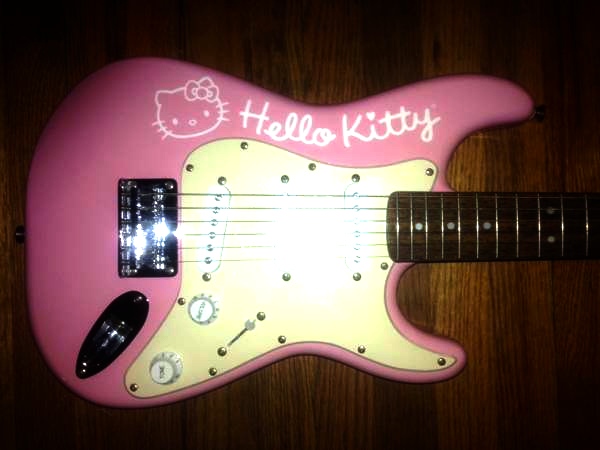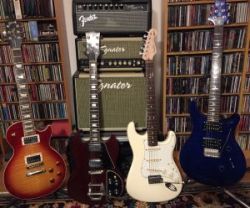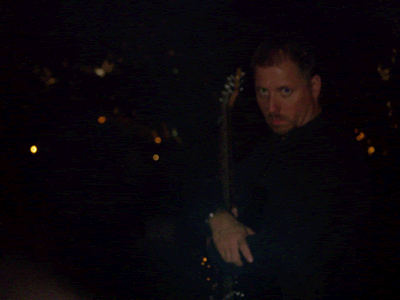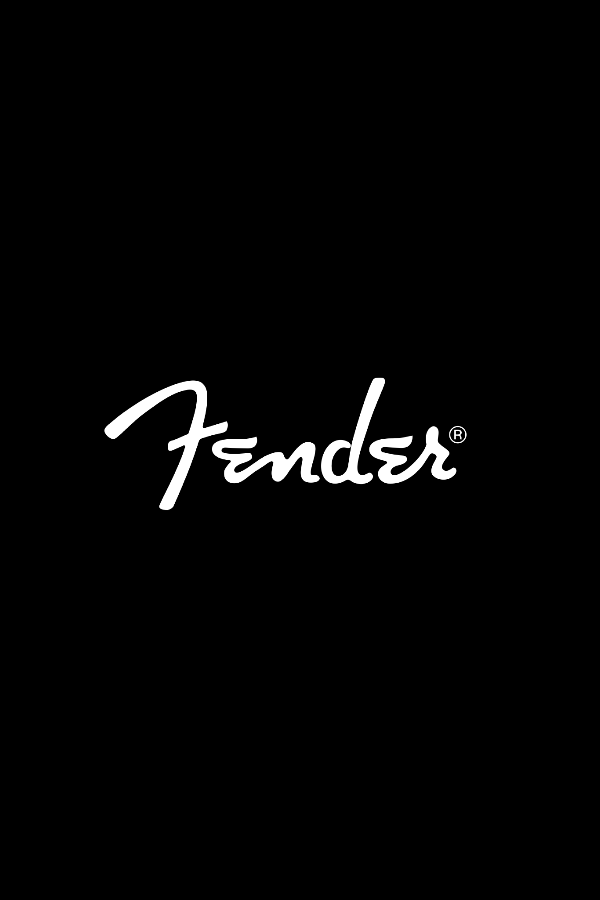Home › Forums › Software and Equipment › Best Pedals for Metal and Rock
- This topic has 25 replies, 12 voices, and was last updated 3 years, 8 months ago by
 superblonde.
superblonde.
-
AuthorPosts
-
-
January 21, 2020 at 1:29 pm #37123
Copperhead
ParticipantI have a bunch of pedals, mostly picked up used at low prices. Ipe did a quick A/B test to see which ones I liked. Although I have Distortion and Overdrive pedals, I’m talking about getting a Metal sound in this post. As an aside, I recently pulled out my Zoom 505, I guess it’s a modeler, more than a pedal. I like it because I can scroll through different settings.
Back to the Metal pedals. I remember in Doug’s old tapes he said to get a Boss Metal Zone. Besides that one, I have a Boss Mega Distortion and a DOD Death Metal Distortion. I looked for reviews, and DL’d manuals for one or two of them. You could literally spend a week reading reviews and watching YouTube videos on these pedals. Basically – some players love them, and some hate them.
Any thoughts or hints on using these? I am strictly a hobbyist, and have different amps, but usually just play a small combo. Can step up to a Fender Mustang or Line 6 if needed. Clasic Rock mostly, but have always liked metal.
-
January 21, 2020 at 2:03 pm #37124
Sarah Spisak
KeymasterI love playing through EZ Mix by Toontrack! It sounds huge at low volume so I can work without ear fatigue. Even over Skype my students often ask “wow- what are you playing through?” LOL
-
January 21, 2020 at 2:36 pm #37125
 rightonthemarkParticipant
rightonthemarkParticipantfor recording i too use ez mix.
it’s quick and easy and sounds great – in my opinion.
for playing live…
years ago i used everything from solid state combo amps to tube half stacks. i primarily used on the floor programmable pedals like boss me6 and korg ax1000g.
loved them both. could get pretty much any sound i needed for being in a cover band.
today…it’s a marshall mg half stack.
just use the amp distortion and just a touch of the fx.
i’ve also added a vox wah and a electro harmonix east river drive just for a little extra push for just a few songs.
i used to love a clean amp with all my distortion from a pedal. now i seem to like amp overdrive with a subtle push from a tube screamer style od for more bite.rock and roll ain't pretty; that's why they picked us to play it.
-
This reply was modified 4 years, 3 months ago by
 rightonthemark.
rightonthemark.
-
This reply was modified 4 years, 3 months ago by
-
January 21, 2020 at 7:23 pm #37128
Copperhead
ParticipantInteresting. I rarely use amp distortion – never found it to my liking. Use it when I’m too lazy to hook up something, and just dinking around.
I imagine many YouTubers are playing direct most of the time. I noticed in Doug’s newer things, I don’t see an amp.
-
January 23, 2020 at 3:17 pm #37140
 Doug MarksKeymaster
Doug MarksKeymasterFor my lessons I haven’t used an amp in years. Some of the lessons have my Line 6 in the background but that’s just to fill the scene. I’m all di.
Metal Method Guitar Instructor
-
-
January 22, 2020 at 8:55 am #37132
 vinayParticipant
vinayParticipantThe Boss Metal Zone has a three band EQ with mid sweep, which is nice. Now there are more pedals that offer this. I’ve got four distortion/overdrive pedals. I first got the Digitech Hardwire TL-2 Metal distortion. It is kind of similar to the Metal Zone but I like the sound a bit better. There is also a tight-loose switch to play with. Later on I got a Joyo Ultimate Drive overdrive/distortion pedal, which I ran in front of the Digitech pedal. It gives you a bit more of a deeper sound, more complex clipping. Webstore Thomann sells pretty much the same pedal under their “Harley Benton” brand name, though funny enough with pretty much the same print as the original Joyo pedal.
I was actually quite happy wit the sound I was getting, when playing through a cheap Washburn six string electric guitar (in which I soon enough installed a DiMarzio MegaDrive bridge humbucker). But when I replaced that guitar with a cheap seven string electric (Jackson JS22-7) I felt the lows just wouldn’t sparkle. That was also what I took from reviews on this guitars, blaming it on the cheap pickups. I was actually prepared to at some point either replace the pickup, or the volume pot (for a 1Meg pot), or bypass the tone pot for the bridge humbucker (the cheapest solution). Then I came across a review on the MXR Fullbore Metal distortion pedal where most people claimed it is way too bright. I got one used and for me it is just perfect when all knobs are at noon (and the scoop button is depressed, fair enough). On the Digitech I was already at the sharp end of the spectrum whereas with this one I’ve lots of room to play with in both direction of what I now call perfect. I’ve also got a TC Electronic Tube Pilot which sounds nice on its own (though obviously far from metal) and adds some dimension in front of the MXR when playing big chords. But with fast riffing I actually prefer to run just the MXR. Just like the Boss and Digitech pedals mentioned, the MXR also has a three band EQ and mid sweep. Plus there is a mid scoop button and a hard noise gate (with internally adjustable threshold).
So yeah, the takeaway is that it depends so much on the guitar you’re using and probably also on the poweramp and cab. I don’t actually use a real/complete amp as it feels like a bit of a waste if I’d only use the poweramp section. So when jamming with friends I play through a Mooer Baby Bomb 30W (8ohm) poweramp pedal through a Vox BC108 cab (25W, 8ohm so not sure if it would survive if I’d dime the power amp) and it is plenty loud. Somehow the managed to make that small cab quite bassy so yeah, that sharp MXR distortion balances it nicely. I recently got this new Electro Harmonix 5mm power amp (2.5W, 8ohm) for playing at home which is really nice. It was hard to make that Mooer amp play at just the right (low) volume whereas on the EHX I’ve got more to play with. Plus it runs off 9V 500mA power so I can just power it directly from my pedal board. You could even get away with running a regular signal cable between power amp and cab though obviously a speaker cable is still ideal. But at least it makes for one thing less to worry about.
But yeah, what are you looking for? What didn’t you like from the ones you’ve tried until now? Reviews don’t necessarily apply to your situation as different guitars and cabinets have a huge effect on the sound. Just like in my case, I felt my dull guitar pickup and bassy cab lacked some sparkle so I intentionally got a distortion pedal which was considered way too bright. Actually the good thing about getting something that people aren’t happy about is that you can get these cheaper used ;).
-
January 22, 2020 at 4:13 pm #37133
Copperhead
ParticipantThanks for the reply. Good point, that the pedal is only one part of the signal chain. Mostly I’m playing for myself but we all like a nice tone, right? I think what prompted it is I’m trying for more of a metal sound with some of the stuff I’m working on. I’ve played more blues or blues rock but now working on Doug’s solos, and similar stuff, so wanted more of metal tone. I knew I had these (collected used over time) so thought I’d try them.
-
January 22, 2020 at 7:23 pm #37135
 superblondeKeymaster
superblondeKeymasterI noticed in Doug’s newer things, I don’t see an amp.
In lesson 2 or 3 or 4 of the new course Doug shows off his mini marshall. for the videos themselves, doug records direct (clean) and uses plugin software amping thru the daw, which plays through monitors into his studio.
i recently got a tube pedal preamp (that can go into PA). i havent been playing much though so not really much chance to test it yet, but what i like is that it can be high gain yet low noise (absence of hiss) and the low gain clean is really really clean.
make note that pedals should be compatible with your pickups, i think. I have EMG81/85 combo so the output is always really heavy.
also, theres several companies now that released preamp pedals with internal speaker amp so theoretically you could just use a pedal board with one of those direct into a cabinet, so no amp required.
I'm an intermediate student of Metal Method. I play seitannic heavy metal. All Kale Seitan! ♯ ♮ ♭ ø ° Δ ♩ ♪ ♫ ♬
And on the Seventh Day, Mustaine said: ∇ ⨯ E = - ∂B / ∂t ; and there was Thrash; and it had a ♭3; and it was good. -
January 23, 2020 at 11:41 pm #37144
 vinayParticipant
vinayParticipantYeah, there are pedals with a power amp built in. Randall has this RG13 which has been around for a good while. What I like about the modular approach (of using a separate power amp pedal like this EHX 5mm I’m using now) is that you can still use it even if you like to use a different overdrive or distortion pedal. If you have the power amp built in, you’ll always need to play through that all-in-one pedal. Or well at least when playing from a pedal board only. What we are seeing now of course is that you have these pedal sized all-in-on pedals which are even smaller than this Randall mentioned. But then again they really are one trick ponies. Which is fine if you find yourself sticking to that one-trick exclusively, of course. Like their Heart Attack amp (which is their high gain amp). It is cool but if you also want to play clean sometimes, you need a different amp.
It is probably the thing we’re juggling with as guitar players (or maybe with other things as well nowadays). If you have an all-in-one device you’re happy with then it will save you a lot of hassle. Until you’re not happy with one of these things. Then you’ll still find yourself dragging other stuff into it until it gets more complex than if you only got what you really needed or wanted. Same thing happens when you buy a bundle of something. My daughter wanted to learn to play electric guitar and I thought it was convenient to start with a simple bundle with a (dual humbucker) kids guitar, cable, picks, headstock tuner, tiny Marshall amp etc. Then realized that the amp overdrive doesn’t do chugga. Got her a distortion pedal. Then realized the tuner isn’t even remotely accurate so for the time being I’m just tuning her guitar ;).
So yeah at the end of the day if you can find a single product that does what you want it to do then that’s great. And for starting out it is probably the cheapest way to get going. But otherwise I think splitting it all up in tiny modules (guitar pedals) that you are happy with is a much safer approach. If you like it now you’ll probably remain fairly happy with it for years (unless it is no longer compatible with your new guitar, obviously). And if you no longer like it, at least you can give or sell it to someone else. A simple distortion pedal or power amp pedal doesn’t go out of style the same way a ten year old modeling amp goes.
-
January 24, 2020 at 4:24 pm #37151
 superblondeKeymaster
superblondeKeymasterthe cool thing about ten year old modeling amps or modeling pedals is that they’re real cheap on the used market since they’re so out of style 😀
there seems to have been a resurgence of metal dudes bringing back their old kidney-bean-shaped line6 pods? the 2nd gen ones.. kinda funny. I dont think the sounds of the other software amps have aged as well as that original line6 unit.I'm an intermediate student of Metal Method. I play seitannic heavy metal. All Kale Seitan! ♯ ♮ ♭ ø ° Δ ♩ ♪ ♫ ♬
And on the Seventh Day, Mustaine said: ∇ ⨯ E = - ∂B / ∂t ; and there was Thrash; and it had a ♭3; and it was good. -
January 25, 2020 at 12:56 pm #37153
 vinayParticipant
vinayParticipantThese digital tools do make for convenient practice solutions. I’ve got a JamVox amp (from Vox indeed) which links to the computer and starts the JamVox software. It is nice because it has a tuner, metronome, drum machine, you can play along with an MP3 file and adjust tempo. You can plug the guitar straight in but instead it also has this DIN type connector for a microphone. And there are jacks for footswitch, expression pedal and some more inputs and headphone. I got it a long time ago though unfortunately it was too heavy for my computer and it often crashed, skipped etc so that was a disappointment. I refuse to invest in expensive and powerful computers because what is expensive now is cheap a year from now. I usually buy a refurbished laptop and use it ’till it breaks. Now, it did break a good while ago and the replacement I bought actually runs the software quite nicely. My hope actually was that I could run GuitarPro simultaneously but that still turns out to be too heavy. Luckily they’re not updating the software (even though they keep releasing compatible hardware) so maybe if I get another computer a couple of years from now, it may actually work. Instead I now actually do have a nice solution with GuitarPro. I’ve got this Vox AmPlug headphone amp (the metal model) with an aux input. I got some kind of Bluetooth receiver from Blackstar. So now this receiver gets the audio signal from GuitarPro and mixes it with my own guitar sound into my headphones. Feels pretty pro, being able to walk around as if I play through a wireless system ;).
For my daughter I eventually got this Zoom G1four processor. Eventually it was just the most convenient solution. It’s got a tuner, drum/metronome, looper and obviously it gets you a decent sound. I may have to try it through my own speaker to hear whether it is really good but at least it is good enough. I thought because the G1on has so little buttons, it is a bit more menu-based which makes it harder for her to control. I looked at a used G3 but these retain their value quite well too. So the newer G1four made more sense. So yeah, maybe digital equipment has indeed come to the point that it is so good that it will retain some more value than gear from ten years ago. I recall I got a used Digitech RP50 or so back then. Was quite horrible to say the least. As it is now, it seems most professional musicians rely on digital equipment for their sound and I get that. They can record wherever they want, no need to hire the expensive studio. And these digital units now are probably more reliable, flexible and consistent than tube amps. And in some cases even cheaper. So yeah that’s great for the professionals. But at the customer end, the ones like us who just like to play for ourselves or with our friends, I’m not sure whether the digital equipment performs as well as a good distortion pedal into a good power amp like what I am running now. More versatile yes, but not as good at doing that one distortion trick. At the end of the day, these Line 6 Pods may have held some value. But so have old Boss Metal Zone and even DS1 distortion pedals. But yeah, got to say my experience is somewhat limited. I tried some cheaper digital units before I eventually settled on that Zoom for my daughter but other than that I avoid bothering what’s the latest gear around. It is enough of a challenge to find time to consistently practice!
-
January 26, 2020 at 7:12 am #37156
Copperhead
ParticipantI wasn’t even factoring in the cost or retained value of anything. I just bought 2 pedals -a Vintage Distortion and Vintage Delay – for $20 each at a pawn shop. Went back and bought another delay pedal for $25. THe Metal Zone and other similar pedals were all used from Guitar Center at low prices. The Zoom I already had but wasn’t that expensive back then.
-
January 26, 2020 at 8:36 am #37157
 superblondeKeymaster
superblondeKeymasterAlso lot of newer rock uses tone shifter pedals which didn’t exist with doug’s older courses, and getting that sound kind of requires the pedal, like the digitech Drop (for similar to Dee J’s sound, industrial-medal) or Pog. Playing a solo which originally used a Pog without having a Pog, isn’t going to have the tone.
I kind of always wanted to try one of the modeller pedals which has a harmonizer, that way my playing or covers sound fatter. It would be helpful for playing at open mic nites where I’m not playing with a band or backing track, just a drum machine. From the perspective of Doug’s course, a student is playing in a band so it’s not necessary. The one-man-guitarist is a different way to go.
The other pedal to have might be a looper and might be more useful for practice than a 2nd distortion pedal. But, I recently sold my high end looper pedal because I didnt end up using it much. Not a big deal to sell it since I bought it used and sold it for almost the same price, which I think is the good way to go.
I'm an intermediate student of Metal Method. I play seitannic heavy metal. All Kale Seitan! ♯ ♮ ♭ ø ° Δ ♩ ♪ ♫ ♬
And on the Seventh Day, Mustaine said: ∇ ⨯ E = - ∂B / ∂t ; and there was Thrash; and it had a ♭3; and it was good. -
January 26, 2020 at 9:00 am #37158
 superblondeKeymaster
superblondeKeymasterI read a totally funny youtube comment just now on a gear video.
“Don’t spend so much on buying weed and you can buy a better guitar.”lol it probably applies to pedal collections as well.
I'm an intermediate student of Metal Method. I play seitannic heavy metal. All Kale Seitan! ♯ ♮ ♭ ø ° Δ ♩ ♪ ♫ ♬
And on the Seventh Day, Mustaine said: ∇ ⨯ E = - ∂B / ∂t ; and there was Thrash; and it had a ♭3; and it was good. -
January 27, 2020 at 9:39 pm #37170
 superblondeKeymaster
superblondeKeymasterCheck out this fantastic video from JHS pedals which demonstrates that many much cheaper Behringer pedals are identical to more expensive BOSS ones. The behringer pedals seem mostly around $25.
apparently there is now a run on the behringer fuzz pedal because of this positive video.
What’s the Deal With Behringer?this is from a yt comment on the video which summarizes the results.
Scoreboard: 9:07 Vibratos, 13:13 Chorus, 18:11 Tube Overdrive, 20:25 Octave Fuzz <- these are all the dead on clones. 3:10 - Tuners: Behringer TU300 vs. BOSS TU-2, no difference specified by Josh 3:28 - Compressors: Behringer CL9 vs. Ibanez CP9, "the circuit is almost the same (...) CL9 has a better bass response (...) I'm torn here." 4:40 - Octavers: UO300 vs. BOSS OC-2, "a little bit of a modification on this old classic." 5:03 - Tremolos: UT300 vs. BOSS TR-2, "buy the BOSS (...) but if you're in a pinch (buy the Behringer.)" 5:26 - Digital Reverbs: DR600 vs. BOSS RV-5, "something is a little off (...) quite off, not bad. " 6:46 - Delays: VD400 vs. BOSS DM-3, "These aren't too expensive so if you have a little extra cash I recommend this (BOSS.)" 7:16 - Envelope Filters: FM600 vs. Line 6 AutoFilter, "They're a little off though because it's a digital circuit (...) They're pretty dead on after I tweaked them." 8:48 - Graphic Equalizers: EQ700 vs. GE-7, "It's an EQ pedal, it does what it should." 9:07 - Vibratos: UV300 vs. BOSS VB-2, VEREDICT: DEAD ON 10:46 - Metal Distortions: UM300 vs. BOSS MT-2, "but you're sitting there going: more Metal Zone." 11:23 - Classic Metal Distortions: HM300 vs. BOSS HM-2, "...definitely inspired by (...) but there's something quite different in the midrange." 12:59 - Noise Supressors: NR300 vs. BOSS NS-2, "It supresses noise." 13:13 - Chorus: UC200 vs. BOSS CH-1, VEREDICT: DEAD ON 13:57 - Tube Screamers: TO800 vs. Ibanez TS808, Josh implied it's the same tone. 14:59 - Tube Distortion: Vintage Tube Monster 15:46 - Analog Delay: Vintage Time Machine vs. Memory Man, "...less headroom overall." 18:11 - Tube Overdrive: Vintage Tube Overdrive vs. Tube Works Tube Driver, VEREDICT: DEAD ON 19:28 - Compressors: CS400 vs. BOSS CS-3, Josh implied it's the same. 19:40 - Amp Modeller: TM300 vs. Sansamp GT2, nothing quoteable :/ 20:25 - Octave Fuzz: SF300 vs. BOSS FZ-2, VEREDICT: DEAD ONI'm an intermediate student of Metal Method. I play seitannic heavy metal. All Kale Seitan! ♯ ♮ ♭ ø ° Δ ♩ ♪ ♫ ♬
And on the Seventh Day, Mustaine said: ∇ ⨯ E = - ∂B / ∂t ; and there was Thrash; and it had a ♭3; and it was good. -
January 28, 2020 at 3:25 pm #37175
 Dave PickeringParticipant
Dave PickeringParticipantI had an MXR Fullbore Metal pedal but really didn’t like it and ended up selling it after only a few weeks. I like the MXR Super Badass Distortion much better.
Here’s blind pedal shootout from a couple of years ago. The Boss Metal Zone didn’t make the cut but the Boss Metal Core did.
Full disclosure: I own the pedal at the 8:43 mark–the one where the guy says, “Wow this is so simple. It’s just got volume and tone”–it’s the Earthquaker Devices Palisades Dual Overdrive which has a circuit which can dial in hundreds of variations on the basic Tube Screamer circuit. It didn’t make the final cut but I really like it a lot.
My biggest fear is when I die, my wife will sell my guitars for what I told her they cost.
-
January 28, 2020 at 4:31 pm #37176
 vinayParticipant
vinayParticipantComplaint I’ve heard of the MXR Fullbore Metal is that it can be too sharp/trebly. And that’s exactly what I got it for ;). Because my guitar has relatively low end pickups especially the low end (seventh string in particular) sounds a bit dull. The too trebly MXR pedal sets that straight. I understand you play the higher end six string guitars so can imagine it doesn’t work well with these. My previous guitar was a six string in which I installed a DiMarzio MegaDrive bridge humbucker. And it sounded really good with my old distortion pedal (Digitech/Hardwire TL-2 Metal Distortion) but I just couldn’t get that one to sound well with the seven string guitar. I may still bypass the bridge humbucker from the tone pot at some point but at this stage I am happy with how it works for me. But I would indeed not recommend this distortion pedal to everyone.
-
February 5, 2020 at 4:51 pm #37202
 ByronParticipant
ByronParticipant👍 on the video from JHS on the Bheringer pedals.
I got the tuner & noise gate pedals based on this video.
I really admire this guy’s honesty; he runs a company making high end boutique pedals and comes out publicly saying that these $25 pedals are worth getting.
-
This reply was modified 4 years, 2 months ago by
 Byron.
Byron.
-
This reply was modified 4 years, 2 months ago by
-
February 6, 2020 at 12:50 pm #37216
 superblondeKeymaster
superblondeKeymasterI thought somewhere in one of the courses, Doug suggests trying multiple metal pedals in a chain, for even more metal. 😀
so maybe, one metal pedal is not enough, just like the JHS video suggests 😁I'm an intermediate student of Metal Method. I play seitannic heavy metal. All Kale Seitan! ♯ ♮ ♭ ø ° Δ ♩ ♪ ♫ ♬
And on the Seventh Day, Mustaine said: ∇ ⨯ E = - ∂B / ∂t ; and there was Thrash; and it had a ♭3; and it was good. -
February 14, 2020 at 10:16 am #37321
 pipelineaudioParticipant
pipelineaudioParticipantI’m really hoping the Pod Go isnt vaporware…it finally has the proper BASIC routing any modeller needs on stage (and Line 6 has known about for years, but has in my opinion actively cripplewared their lower end products)
This guy is a bit pricey, but still very very capable if it lives up to its claims
-
February 14, 2020 at 1:31 pm #37322
 Shroud1969Participant
Shroud1969Participant@pipeline – Check out the Mooer GE250. For me, it’s that vs. the Go as my next acquisition.
Here’s a great demo of it:
Give me your thoughts on tone.
-
This reply was modified 4 years, 2 months ago by
 Shroud1969.
Shroud1969.
-
This reply was modified 4 years, 2 months ago by
-
February 14, 2020 at 8:20 pm #37324
 superblondeKeymaster
superblondeKeymasterLatest Bumblefoot / Billy Sheehan interview
can’t argue with the greatest of all time..
What setup do you use to record with at home?
Bumblefoot: This will piss off the purists: my guitar, plugged into my computer, and either an IK Multimedia AmpliTube or a Line 6 Helix Native.No amps and no mics?
Bumblefoot: Ampless.Sheehan: It was all direct. I used the Helix and an Ashly Audio compressor. The Helix has been glorious for doing tracks. If somebody calls me, I grab it, put it in the car, get there, and get everything we need—it’s really been wonderful. I often record sitting in the control room, so I’m used to what it sounds like, whether it’s an amp out there, or I’m going direct. Sometimes in a session, I’ll plug right into the console, add a little EQ, possibly a touch of compression, and play like that—depending on the session, of course. For Sons of Apollo, we needed a really grindy, pounding, frightening bass tone. I’m really pleased with the way it came out.
Bumblefoot: I’ve been a Line 6 guy for 20 years, since the POD 2.0. When you find the right impulse responses to make it feel like you’re moving air, you can really get some nice stuff happening. And with the kind of touring I do, which is so diverse—one day I’ll be doing a guitar clinic, the next day I might be playing at a big festival with a band, the day after that might be an acoustic show, or some kind of one-man storytelling evening—it’s great having all your sounds there. … What I found interesting was that Steve Howe also uses the Helix. He uses the Helix into the Line 6 flat response cabinets—almost like floor monitor speakers.
Bumblefoot’s Gear
Amps
IK Multimedia AmpliTube (studio)
Line 6 Helix Native (tour)
Engl Invader 2 100-watt head with 4×12 cabinetEffects
Morley Wah
TC Electronic Sub ’N’ Up
TC Electronic Flashback Delay
TC Electronic Corona Chorus
TC Electronic Vortex Flanger
TC Electronic Hall of fame ReverbI'm an intermediate student of Metal Method. I play seitannic heavy metal. All Kale Seitan! ♯ ♮ ♭ ø ° Δ ♩ ♪ ♫ ♬
And on the Seventh Day, Mustaine said: ∇ ⨯ E = - ∂B / ∂t ; and there was Thrash; and it had a ♭3; and it was good. -
February 15, 2020 at 8:21 am #37326
 vinayParticipant
vinayParticipantYeah I get that plugging straight into their computer makes a lot of sense for these professional artists. After all they most likely already use a powerful computer with big monitors for recording at home. Capturing ideas and sharing them with band members across the world (especially for artists who perform in several project bands). I read an interview with Chris Broderick where he said the band recorded the entire debut without having played together once. Technology has definitely changed the way musicians work these days. Probably also explains how they manage to have so many side projects. Either way, I think for such professional artists this is business and it is worth investing in the equipment it requires. But I personally don’t need a powerful computer at all. And I kind of dislike the computer/cellphone industry so I don’t feel like investing in the latest and greatest stuff that will be worth half the money a year from now. If I’d buy a computer and monitor capable of sounding as well as a simple distortion pedal into a power amp into a cab, I’d have to invest several times what this simple gear has cost me. I’d rather just get this simple gear ;). And because the prices don’t change much (unless it is the latest digital stuff) it feels fair, like I actually paid what it should cost. Then again I’m just a simple guitar enthusiast who’s happy with the sound of playing through distortion and power amp. When an artist needs a million different sound patches, the computer probably starts to make more sense. Even then though, I’d probably prefer playing through a digital processing unit or digital amp than straight through a powerful computer.
-
April 28, 2020 at 7:05 am #37779
Anonymous
InactiveI only use amps live. At home I mainly use the amp models on my Zoom R8 (they really are incredible) or the models Studio One, or Logic Pro. Mainstage also has some nice models. I also have an ADA MP-1 preamp which still gets used.
Live it’s my trusty old solid state Peavey Special 212 silver stripe, and my pedal board.
Metal pedal? I really dig the Wampler Dracarys. Personally though, I have two distortions boxes. I use a DOD Gunslinger, and I also have a Boss DS1 that I modded myself. I did the JCM 800 and super high gain mods outlined by Brian Wampler in Premier guitar. But….I also use a compressor as an always on pedal. And that also affects the gain structure of your distortion
I also like the Seymour Duncan Palladium gain stage. It’s really good for modern stuff. The MXR super badass, and the 5150 overdrive (I don’t know why they labeled it overdrive, it definitely can grind). The old Boss digital metalizer is really good even if it IS discontinued. Great analog distortion with digital delay, and chorus built in. It doubles nicely to give you thos really fat textures. It is good enough for David Gilmour so ’nuff said about that one.The digital metalizer is one I wish I hadn’t let go of.
-
July 22, 2020 at 9:46 pm #38178
 LeoParticipant
LeoParticipantIn lesson 2 or 3 or 4 of the new course Doug shows off his mini marshall.
Just wondering is that an older style of that little marshal? I Picked one up like it and mine sounded horrendous. I mainly just wanted something I could play low and also even play with headphones for very low since I’m a night owl. My little marshal amp seems to only want to roar but in a way that’s too noisey to sound good. I was thinking of putting it on EBAY but I wouldn’t even want to pitch it to someone as being a decent sounding amp. Mine is a MG10, and another thing it does is seems to make the low E BOOM and so on compared to the higher strings. Not in a good way and not in the way my other amps sound.
Maybe mine is defective? or is it a pos?
demonstrates that many much cheaper Behringer pedals are identical to more expensive BOSS ones.
I have the Behringer Metal Pedal as my first and only pedal, and I have some fun with it. Im not an expert at tuning things up, so I settle for less than the sound I REALLY want. But anyway just playing day to day I’m pretty happy with play strait through my amp usually. I have a few amps now as well as another high end Marshal I just love and am happy just turning the built in knobs on it mostly. I was looking into another Behringer Noise Suppressor or something like that. I Thought I might be a fool for buying multiple cheap pedals, but I think this brand might be on to something. Down the road I’d pick up more specific and high end gear but I have a lot of fun with my Behringer Metal Pedal, the only problem is have it it gets ‘noisey’, have have to mute my strings like a pro or just let everything sound like it’s echoing through the pit of electric doom.
-
July 27, 2020 at 7:31 pm #38198
 superblondeKeymaster
superblondeKeymasterMaybe its the difference from your pickups? Lots of times I tried to understand tone and the typical video demos dont explain what pickups were used or how that changes an amp’s tone. In the older course (1990’s one) Doug has a ‘metal tone’ demo using a couple pedals (boss metal zone?) where he says something like “adjust the dials until it sounds like an army of ants” lol
It could also be guitar strings. I followed Doug’s suggestion from the course and it massively improved the tone of my squier which has the cheapest fender single coil pickups, which sounded hollow and tinny before that. You could try thinner or thicker or different types (nickel percentage etc) since after all, pickups work based on the magnetic field of the strings.
With the noisey problem maybe a noise gate is needed.
I'm an intermediate student of Metal Method. I play seitannic heavy metal. All Kale Seitan! ♯ ♮ ♭ ø ° Δ ♩ ♪ ♫ ♬
And on the Seventh Day, Mustaine said: ∇ ⨯ E = - ∂B / ∂t ; and there was Thrash; and it had a ♭3; and it was good.
-
-
AuthorPosts
- You must be logged in to reply to this topic.
